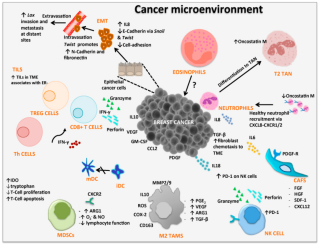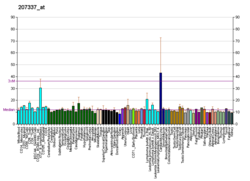Immunotherapy or biological therapy is the treatment of disease by activating or suppressing the immune system. Immunotherapies designed to elicit or amplify an immune response are classified as activation immunotherapies, while immunotherapies that reduce or suppress are classified as suppression immunotherapies. Immunotherapy is under preliminary research for its potential to treat various forms of cancer.
Heat shock proteins (HSP) are a family of proteins produced by cells in response to exposure to stressful conditions. They were first described in relation to heat shock, but are now known to also be expressed during other stresses including exposure to cold, UV light and during wound healing or tissue remodeling. Many members of this group perform chaperone functions by stabilizing new proteins to ensure correct folding or by helping to refold proteins that were damaged by the cell stress. This increase in expression is transcriptionally regulated. The dramatic upregulation of the heat shock proteins is a key part of the heat shock response and is induced primarily by heat shock factor (HSF). HSPs are found in virtually all living organisms, from bacteria to humans.
A cancer vaccine is a vaccine that either treats existing cancer or prevents development of cancer. Vaccines that treat existing cancer are known as therapeutic cancer vaccines or tumor antigen vaccines. Some of the vaccines are "autologous", being prepared from samples taken from the patient, and are specific to that patient.

Cluster of differentiation 40, CD40 is a type I transmembrane protein found on antigen-presenting cells and is required for their activation. The binding of CD154 (CD40L) on TH cells to CD40 activates antigen presenting cells and induces a variety of downstream effects.

Cancer immunology is an interdisciplinary branch of biology that is concerned with understanding the role of the immune system in the progression and development of cancer; the most well known application is cancer immunotherapy, which utilises the immune system as a treatment for cancer. Cancer immunosurveillance and immunoediting are based on protection against development of tumors in animal systems and (ii) identification of targets for immune recognition of human cancer.

Programmed death-ligand 1 (PD-L1) also known as cluster of differentiation 274 (CD274) or B7 homolog 1 (B7-H1) is a protein that in humans is encoded by the CD274 gene.
An oncoantigen is a surface or soluble tumor antigen that supports tumor growth. A major problem of cancer immunotherapy is the selection of tumor cell variants that escape immune recognition. The notion of oncoantigen was set forth in the context of cancer immunoprevention to define a class of persistent tumor antigens not prone to escape from immune recognition.

Melanoma-associated antigen 3 (MAGE-A3) is a protein that in humans is encoded by the MAGEA3 gene.

Protein SSX2 is a protein that in humans is encoded by the SSX2 gene.

Melanoma-associated antigen 4 is a protein that in humans is encoded by the MAGEA4 gene.

Lymphocyte-activation gene 3, also known as LAG-3, is a protein which in humans is encoded by the LAG3 gene. LAG3, which was discovered in 1990 and was designated CD223 after the Seventh Human Leucocyte Differentiation Antigen Workshop in 2000, is a cell surface molecule with diverse biologic effects on T cell function. It is an immune checkpoint receptor and as such is the target of various drug development programs by pharmaceutical companies seeking to develop new treatments for cancer and autoimmune disorders. In soluble form it is also being developed as a cancer drug in its own right.

Melanoma-associated antigen C2 is a protein that in humans is encoded by the MAGEC2 gene.

Fetal and Adult Testis-Expressed 1, encoded by the FATE1 gene in humans, is a protein identified as a cancer-testis antigen (CTA) in hepatocellular carcinomas and gastric and colon cancers. It is testis-specific in the fetus. In adults, it is expressed predominantly in the testis and adrenal glands, with some expression in the lungs, heart, kidneys and throughout the brain.

G antigen family D member 2 is a protein that in humans is encoded by the XAGE1D gene.

Sperm protein associated with the nucleus on the X chromosome A is a protein that in humans is encoded by the SPANXA1 gene.

Protein SSX5 is a protein that in humans is encoded by the SSX5 gene.
Immunoediting is a dynamic process that consists of immunosurveillance and tumor progression. It describes the relation between the tumor cells and the immune system. It is made up of three phases: elimination, equilibrium, and escape.
Cancer/testis (CT) antigens are a group of proteins united by their importance in development and in cancer immunotherapy. In general, expression of these proteins is restricted to male germ cells in the adult animal. However, in cancer these developmental antigens are often re-expressed and can serve as a locus of immune activation. Thus, they are often classified as tumor antigens. The expression of CT antigens in various malignancies is heterogeneous and often correlates with tumor progression. CT antigens have been described in melanoma, liver cancer, lung cancer, bladder cancer, and pediatric tumors such as neuroblastoma. Gametogenesis offers an important role for many of these antigens in the differentiation, migration, and cell division of primordial germ cells, spermatogonia spermatocytes and spermatids. Because of their tumor-restricted expression and strong in vivo immunogenicity, CT antigens are identified as ideal targets for tumor specific immunotherapeutic approaches and prompted the development of several clinical trials of CT antigens-based vaccine therapy. CT antigens have been found to have at least 70 families so far, including about 140 members, most of which are expressed during spermatogenesis. Their expression are mainly regulated by epigenetic events, specifically, DNA methylation.
The Immunologic Constant of Rejection (ICR), is a notion introduced by biologists to group a shared set of genes expressed in tissue destructive-pathogenic conditions like cancer and infection, along a diverse set of physiological circumstances of tissue damage or organ failure, including autoimmune disease or allograft rejection. The identification of shared mechanisms and phenotypes by distinct immune pathologies, marked as a hallmarks or biomarkers, aids in the identification of novel treatment options, without necessarily assessing patients phenomenologies individually.
Whole-cell vaccines are a type of vaccine that has been prepared in the laboratory in such a way to express immune cells such as cytokines, chemokines and other costimulatory molecules. When administered to the patients, these molecules will stimulate the immune system of the patient. The whole-cell vaccine simultaneously targets multiple antigens to activate the immune system and induces antigen-specific T-cell responses.











